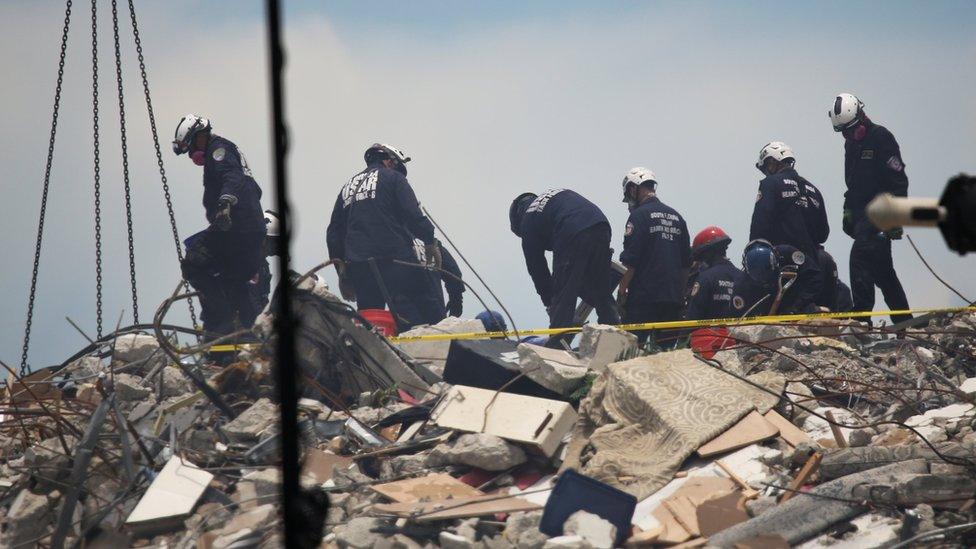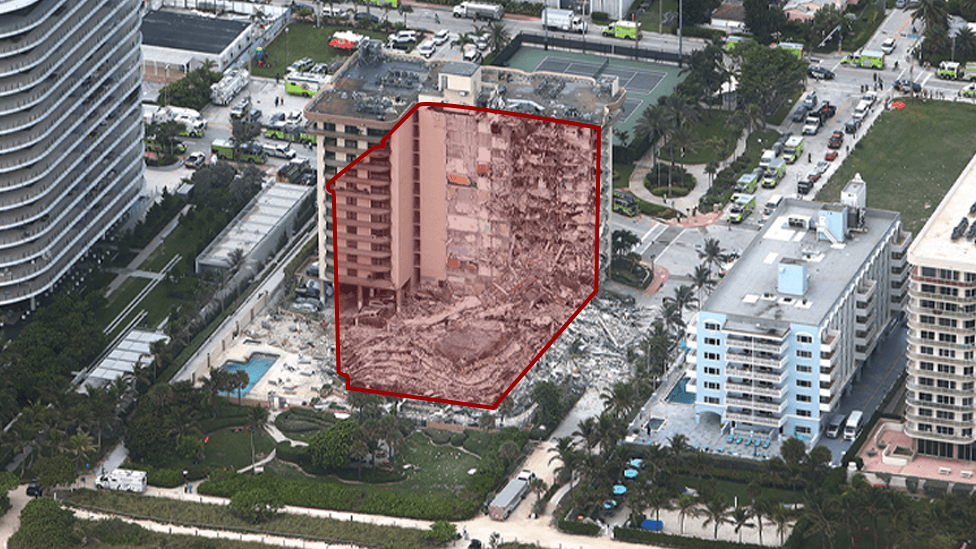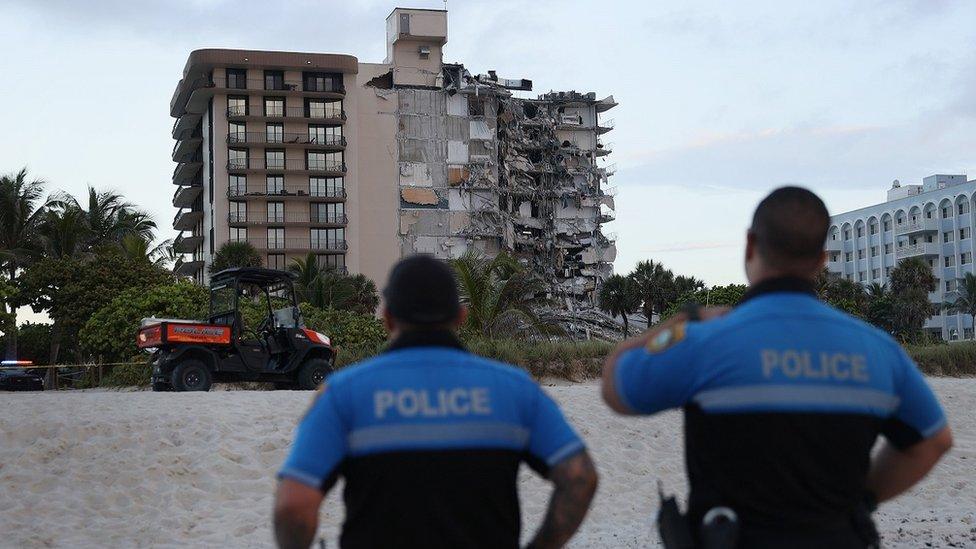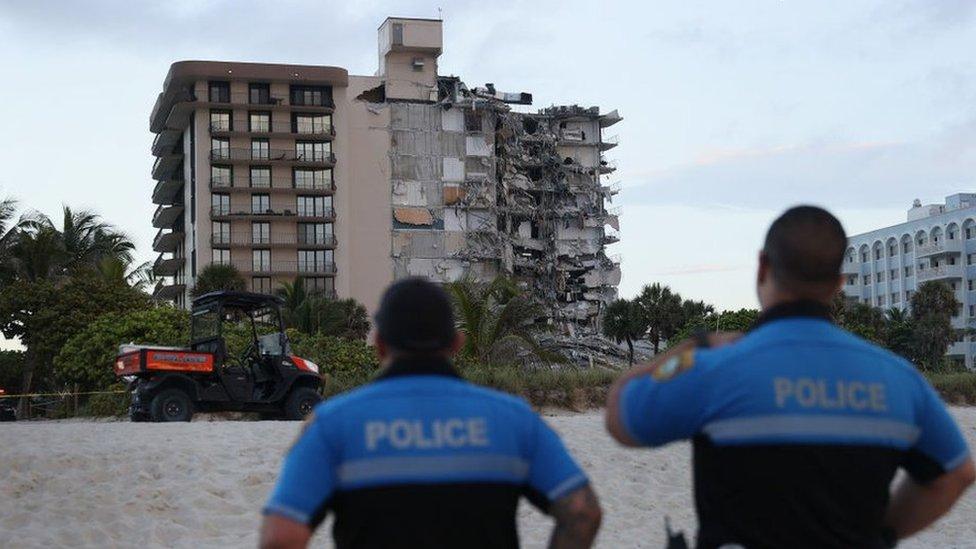Florida building collapse: More than 150 missing, ten dead
- Published

Rescuers have worked non-stop to find survivors
Rescue workers say they are searching "every bit of hope" as the hunt for survivors under the rubble of a collapsed Florida apartment block continues into a fifth day.
More than 150 people are still missing, with ten people confirmed to have died in Thursday's early morning disaster.
Just four of the victims have been identified so far.
The cause of the collapse in Surfside, north of Miami, remains unclear.
An engineer's report from 2018, external, which was made public on Saturday, highlighted "a major error" in the original design of the 12-storey seafront Champlain Towers. It said the fault prevented water draining away from the base of the building.
On Sunday, officials were keen to stress they were still hoping to find survivors. Teams have been working solidly since the building collapsed, and have now been joined by rescue workers from Israel and Mexico.
However, the initial efforts were slowed by a fire in the debris, which is thought to have been brought under control. Surfside Mayor Charles Burkett previously described how the building had "pancaked", with spaces that were 10ft or more reduced to "just feet".
Firefighters search for survivors under collapsed Miami building
A 125ft (38m) trench, which is 40ft deep, has now been dug to assist in the search for any pockets where people may have survived.
Miami-Dade Fire Chief Alan Cominsky acknowledged they were still facing an "extremely difficult situation" but were not prepared to give up.
"Our rescue teams are non-stop, doing all that we can, searching every area, every bit of hope to see if we can find a live victim," he told reporters.
Who are the victims?
Eight of the ten victims have been named by officials so far: Gladys Lozano, 79, and her husband Antonio, 83; Stacie Fang, 54; Manuel LaFont, also 54; Leon Oliwkowiicz, 80; Christina Beatriz Elvira, 74; Luis Andres Bermudez, 26, and his mother Anna Ortiz, 46.
Ms Fang's son, 15, was pulled alive from the rubble.
The remains of the other five people pulled from the debris are undergoing DNA tests to establish their identities.
What happened to the building?
The building contained 136 apartments and 55 of them collapsed early on Thursday, leaving piles of debris.
Resident Barry Cohen was in bed in a section of the building that survived when the collapse happened. "It sounded like thunder, and my wife and I, we went out on the balcony; it looked like a bomb had exploded," he told the BBC.
"When we opened the door, there was no building there, it was just a pile of rubble," he said.
Eyewitnesses described hearing what sounded like thunder before seeing a huge cloud of dust in the aftermath of the collapse.


A full investigation into the collapse is set to begin after the rescue mission.
As the building has stood since 1980, it was due its standard 40-year review. It was undergoing its "recertification" process and required repairs, officials said.
The 2018 engineer's report into the building flagged "major structural damage" to the concrete platform beneath the swimming pool deck. It also referred to "abundant cracking… of columns, beams and walls" in the garage.
The report didn't suggest the 40-year-old building was at any imminent risk of collapse but its author, engineer Frank Morabito, urged that the concrete repairs be carried out in "a timely fashion".
Meanwhile, a study from researchers at Florida International University published last year found that the building had been sinking at a rate of two millimetres per year in the 1990s, which may have affected the building structurally.
But the author has cautioned that the study was just a snapshot in time. The building was constructed on reclaimed wetland, which experts say is always of concern as the land underneath can compact over time, leading to shifts.
On the sinking, the author of the study, Prof Shimon Wdowinski, told the Miami Herald newspaper: "We've seen much higher than that, but it stood out because most of the area was stable and showed no subsidence."
Prof Wdowinski said the research was not meant to suggest certainty about the latest incident.
Related topics
- Published28 June 2021

- Published24 July 2021

- Published24 June 2021

- Published25 June 2021
